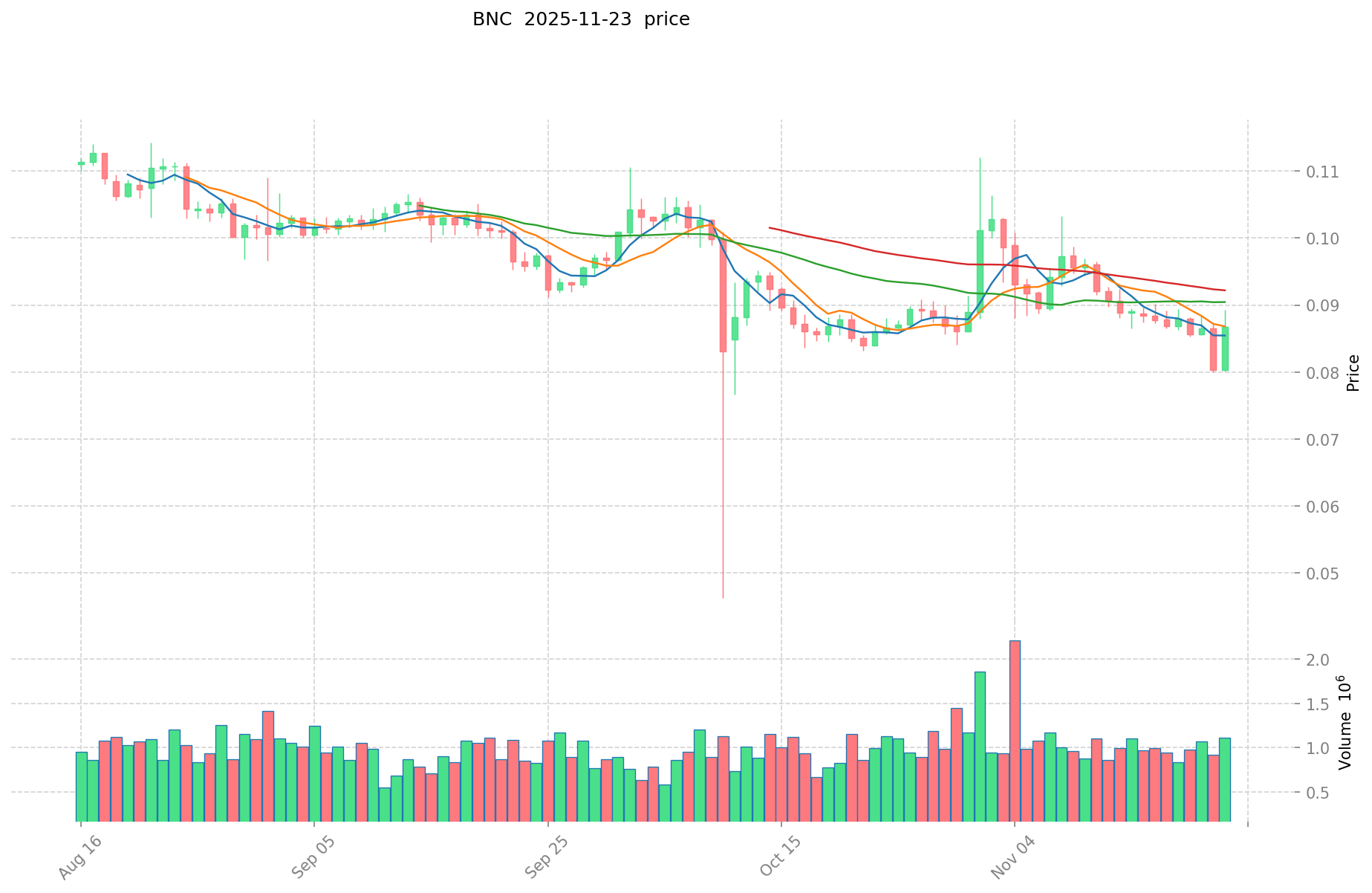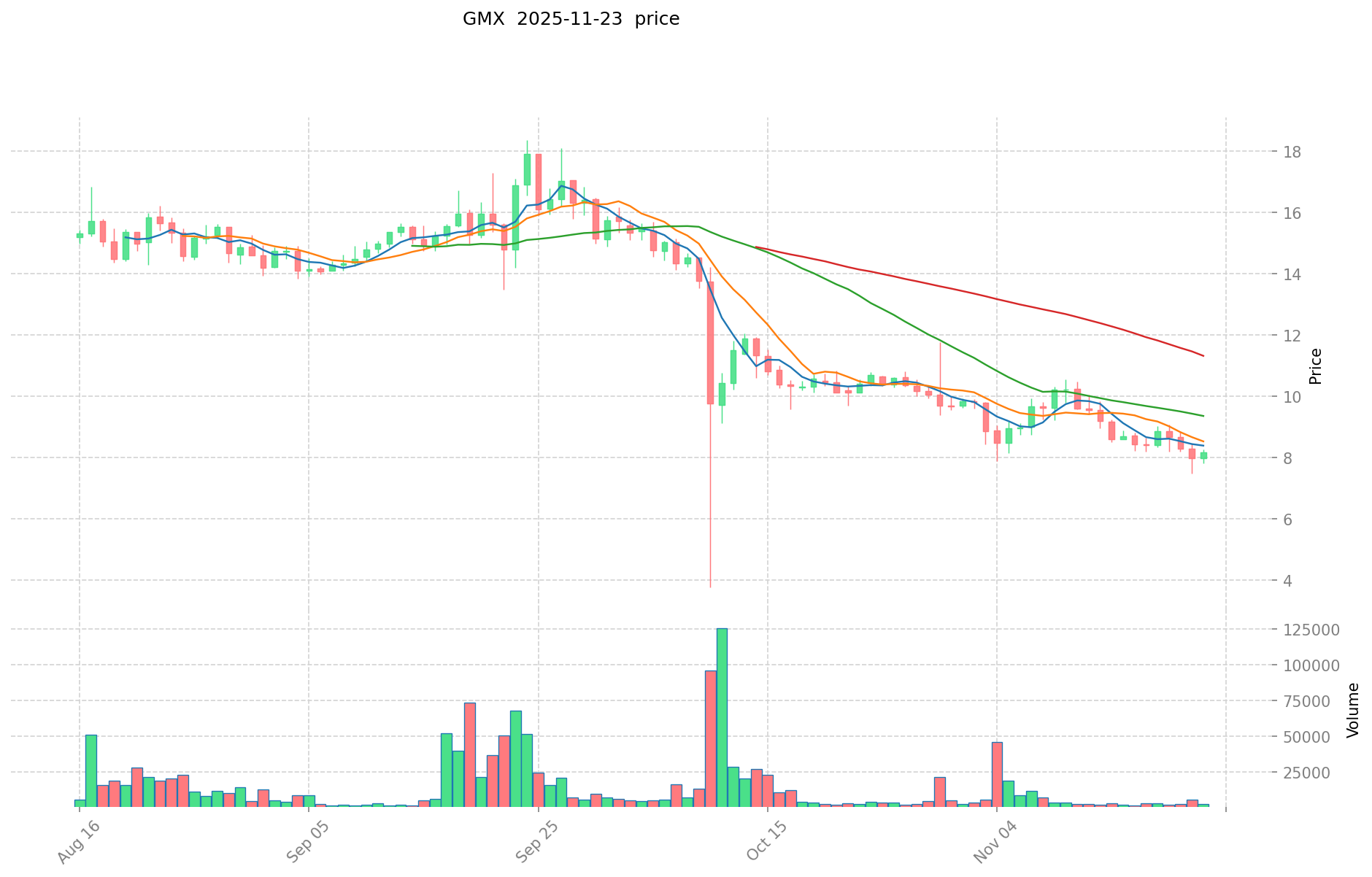BNC vs GMX: A Comparative Analysis of Two Leading Cryptocurrency Exchanges
Introduction: BNC vs GMX Investment Comparison
In the cryptocurrency market, the comparison between Bifrost (BNC) vs GMX (GMX) has always been a topic that investors can't avoid. The two not only have significant differences in market cap ranking, application scenarios, and price performance, but also represent different cryptocurrency asset positioning.
Bifrost (BNC): Launched in 2019, it has gained market recognition for its focus on providing liquidity for staked assets in the Polkadot ecosystem.
GMX (GMX): Established as a decentralized perpetual exchange, it has been recognized for its utility and governance token model.
This article will comprehensively analyze the investment value comparison between BNC vs GMX, focusing on historical price trends, supply mechanisms, institutional adoption, technological ecosystems, and future predictions, attempting to answer the question most important to investors:
"Which is the better buy right now?"
I. Price History Comparison and Current Market Status
BNC and GMX Historical Price Trends
- 2021: BNC reached its all-time high of $6.14 on November 3, 2021.
- 2022: BNC hit its all-time low of $0.077236 on November 14, 2022.
- 2023: GMX reached its all-time high of $91.07 on April 18, 2023.
- 2025: GMX hit its all-time low of $6.92 on October 11, 2025.
Comparative Analysis: During the market cycle, BNC experienced a significant drop from its peak of $6.14 to its low of $0.077236, while GMX showed a similar trend, falling from $91.07 to $6.92.
Current Market Situation (2025-11-23)
- BNC current price: $0.08662
- GMX current price: $8.268
- 24-hour trading volume: BNC $92,010.42 vs GMX $19,154.87
- Market Sentiment Index (Fear & Greed Index): 13 (Extreme Fear)
Click to view real-time prices:
- Check BNC current price Market Price
- Check GMX current price Market Price


II. Core Factors Affecting Investment Value of BNC vs GMX
Supply Mechanism Comparison (Tokenomics)
- BNC: Bonk uses a deflationary model with token burns occurring regularly through various mechanisms, including transaction fees and promotional burns.
- GMX: GMX has a maximum supply cap with emissions distributed to stakers as protocol rewards, following a more controlled issuance schedule.
- 📌 Historical Pattern: Deflationary tokens like BNC tend to create price pressure during high demand periods, while GMX's reward-based emissions provide ongoing incentives for long-term protocol participation.
Institutional Adoption and Market Applications
- Institutional Holdings: GMX has gained more institutional recognition due to its established derivatives trading protocol and sustainable revenue model.
- Enterprise Adoption: GMX has stronger integration with various DeFi protocols and trading platforms, while BNC primarily functions as a community token with expanding merchant acceptance in the Solana ecosystem.
- Regulatory Attitudes: Both tokens face regulatory uncertainty, though GMX as a DeFi protocol token potentially faces more scrutiny due to its derivatives trading functionality.
Technical Development and Ecosystem Building
- BNC Technical Upgrades: Expanding ecosystem applications including NFT projects, gaming integrations, and merchant payment solutions within the Solana ecosystem.
- GMX Technical Development: Implementation of GMX V2 with improved liquidity management, lower fees, and enhanced trading features like partial liquidations and range orders.
- Ecosystem Comparison: GMX has established itself as a leading decentralized perpetual exchange with real yield, while BNC is focused on community engagement, meme culture, and increasing utility across the Solana DeFi landscape.
Macroeconomic Environment and Market Cycles
- Inflation Performance: GMX demonstrates stronger inflation resistance through its fee-sharing model generating actual revenue, while BNC relies more on market sentiment and adoption metrics.
- Macroeconomic Monetary Policy: Interest rate changes typically impact GMX's trading volumes and fee generation, while BNC as a meme token may be more affected by overall risk sentiment in crypto markets.
- Geopolitical Factors: GMX benefits from increased trading activity during market uncertainty, while BNC's performance is more tied to overall Solana ecosystem growth and adoption.
III. 2025-2030 Price Prediction: BNC vs GMX
Short-term Prediction (2025)
- BNC: Conservative $0.0536 - $0.0865 | Optimistic $0.0865 - $0.1064
- GMX: Conservative $5.115 - $8.25 | Optimistic $8.25 - $10.725
Mid-term Prediction (2027)
- BNC may enter a growth phase, with prices expected in the range of $0.0663 - $0.1634
- GMX may enter a consolidation phase, with prices expected in the range of $9.427 - $14.238
- Key drivers: Institutional capital inflow, ETF, ecosystem development
Long-term Prediction (2030)
- BNC: Base scenario $0.0943 - $0.1684 | Optimistic scenario $0.1684 - $0.2189
- GMX: Base scenario $10.161 - $15.165 | Optimistic scenario $15.165 - $20.321
Disclaimer
BNC:
| 年份 | 预测最高价 | 预测平均价格 | 预测最低价 | 涨跌幅 |
|---|---|---|---|---|
| 2025 | 0.1063581 | 0.08647 | 0.0536114 | 0 |
| 2026 | 0.1320872485 | 0.09641405 | 0.061704992 | 11 |
| 2027 | 0.1633784284275 | 0.11425064925 | 0.066265376565 | 31 |
| 2028 | 0.180458900490375 | 0.13881453883875 | 0.093005741021962 | 60 |
| 2029 | 0.177196758827664 | 0.159636719664562 | 0.105360234978611 | 84 |
| 2030 | 0.218941761019947 | 0.168416739246113 | 0.094313373977823 | 94 |
GMX:
| 年份 | 预测最高价 | 预测平均价格 | 预测最低价 | 涨跌幅 |
|---|---|---|---|---|
| 2025 | 10.725 | 8.25 | 5.115 | 0 |
| 2026 | 10.151625 | 9.4875 | 8.254125 | 14 |
| 2027 | 14.238365625 | 9.8195625 | 9.42678 | 18 |
| 2028 | 13.352150109375 | 12.0289640625 | 7.698537 | 45 |
| 2029 | 17.639874349453125 | 12.6905570859375 | 11.42150137734375 | 53 |
| 2030 | 20.321389061711718 | 15.165215717695312 | 10.160694530855859 | 83 |
IV. Investment Strategy Comparison: BNC vs GMX
Long-term vs Short-term Investment Strategies
- BNC: Suitable for investors focused on community-driven projects and Solana ecosystem growth
- GMX: Suitable for investors seeking exposure to DeFi trading protocols with sustainable revenue models
Risk Management and Asset Allocation
- Conservative investors: BNC: 20% vs GMX: 80%
- Aggressive investors: BNC: 40% vs GMX: 60%
- Hedging tools: Stablecoin allocation, options, cross-currency portfolio
V. Potential Risk Comparison
Market Risks
- BNC: High volatility due to meme token status and dependency on community sentiment
- GMX: Exposure to overall crypto market conditions and trading volume fluctuations
Technical Risks
- BNC: Scalability issues on Solana, network congestion
- GMX: Smart contract vulnerabilities, liquidity risks in extreme market conditions
Regulatory Risks
- Global regulatory policies may have a more significant impact on GMX due to its derivatives trading functionality, while BNC may face less scrutiny as a community token
VI. Conclusion: Which Is the Better Buy?
📌 Investment Value Summary:
- BNC advantages: Strong community support, potential for viral growth, expanding utility in Solana ecosystem
- GMX advantages: Established DeFi protocol, sustainable revenue model, ongoing technical improvements
✅ Investment Recommendations:
- Novice investors: Consider a small allocation to BNC for exposure to community-driven projects, with a larger position in GMX for more established DeFi exposure
- Experienced investors: Balanced approach with tactical adjustments based on market cycles and ecosystem developments
- Institutional investors: Focus on GMX for its more established protocol and revenue model, while monitoring BNC for potential breakout opportunities
⚠️ Risk Warning: Cryptocurrency markets are highly volatile, and this article does not constitute investment advice. None
VII. FAQ
Q1: What are the main differences between BNC and GMX? A: BNC is a community-driven token in the Solana ecosystem focusing on meme culture and expanding utility, while GMX is an established decentralized perpetual exchange protocol with a sustainable revenue model.
Q2: Which token has shown better price performance historically? A: GMX has shown better overall price performance, reaching an all-time high of $91.07 in April 2023, compared to BNC's all-time high of $6.14 in November 2021.
Q3: How do the supply mechanisms of BNC and GMX differ? A: BNC uses a deflationary model with regular token burns, while GMX has a maximum supply cap with emissions distributed to stakers as protocol rewards.
Q4: Which token is more likely to attract institutional investors? A: GMX is more likely to attract institutional investors due to its established derivatives trading protocol and sustainable revenue model.
Q5: What are the key factors affecting the long-term value of each token? A: For BNC, key factors include community engagement, Solana ecosystem growth, and expanding utility. For GMX, factors include trading volume, protocol improvements, and DeFi market trends.
Q6: How do the investment strategies differ for BNC and GMX? A: BNC is suitable for investors focused on community-driven projects and Solana ecosystem growth, while GMX is better for those seeking exposure to DeFi trading protocols with sustainable revenue models.
Q7: What are the main risks associated with investing in BNC and GMX? A: BNC faces high volatility due to its meme token status and dependency on community sentiment. GMX is exposed to overall crypto market conditions, trading volume fluctuations, and potential regulatory scrutiny due to its derivatives trading functionality.
Share
Content